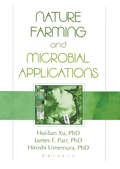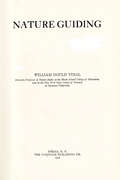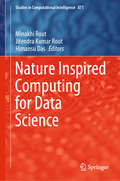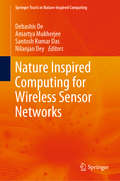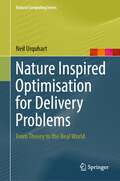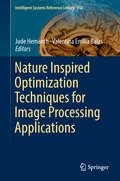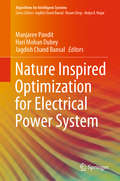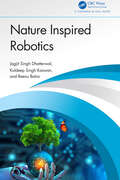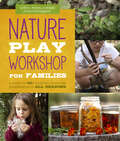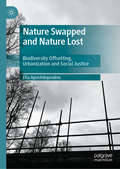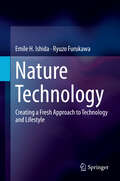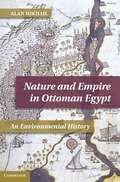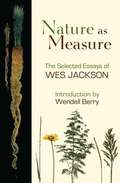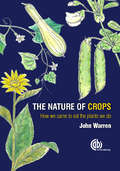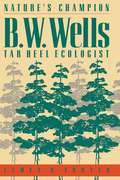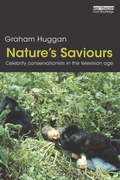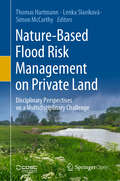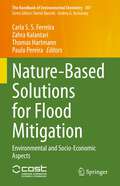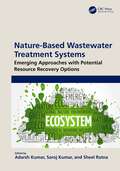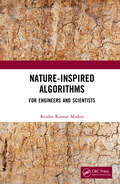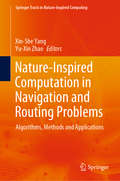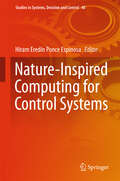- Table View
- List View
Nature Farming and Microbial Applications
by Hiu-lian Xu Hiroshi Umemura James F. Parr JrProduce more abundant, high-quality crops with the information you'll find in this book!Recent concerns over environmental pollution and food quality degradation caused by the excessive use of chemicals have prompted scientists and policymakers to re-evaluate modern agricultural processes and search for alternatives that will aid in the production of healthy foods and the protection of our environment. Nature Farming and Microbial Applications summarizes current research in the field, highlighting unique practices such as the use of microbial inoculants and various alternatives to chemical fertilizers and pesticides. The principles of nature farming, as set forth by Japanese philosopher Mokichi Okada, must fulfill these requirements: producing safe and nutritious food that promotes good health providing economic and spiritual benefits to both producers and consumers being sustainable and easily practiced conserving and protecting the environment producing sufficient high-quality food for an expanding world populationTo this end, Nature Farming and Microbial Applications addresses issues of concern to organic farmers, including: soil fertility pest control effective microorganisms photosynthesis transpiration plant-water relations stress resistance of growing cropsThis well-referenced volume contains unique and original methods of modeling and analysis. It will be used again and again as a reference source for students and researchers.
Nature Guiding
by William Gould VinalNature Guiding is the science of inculcating nature enthusiasm, nature principles, and nature facts into the spirit of individuals. "Doing" nature-study means observing, wondering, and solving problems. It could include collecting, building, measuring, painting, planning, writing, touching, experimenting or any of a wide range of other activities. Most importantly, it allows children to be "original investigators."This book is intended as a resource for teachers and students engaged in nature study at summer camps and in schools. William Gould Vinal believed that the teacher of nature study should be "in sympathy with the simple life and the country way," that the nature study should emphasize observation of the interactions of plants and animals in their environment, and not be reduced to matters of taxonomy and anatomy. In Nature Guiding, he offers advice to camp counselors and school teachers on incorporating nature study into everyday activities, as well as suggestions for parents and others about using visits to state and national parks to teach nature lore.
Nature Inspired Computing for Data Science (Studies in Computational Intelligence #871)
by Himansu Das Minakhi Rout Jitendra Kumar RoutThis book discusses the current research and concepts in data science and how these can be addressed using different nature-inspired optimization techniques. Focusing on various data science problems, including classification, clustering, forecasting, and deep learning, it explores how researchers are using nature-inspired optimization techniques to find solutions to these problems in domains such as disease analysis and health care, object recognition, vehicular ad-hoc networking, high-dimensional data analysis, gene expression analysis, microgrids, and deep learning. As such it provides insights and inspiration for researchers to wanting to employ nature-inspired optimization techniques in their own endeavors.
Nature Inspired Computing for Wireless Sensor Networks (Springer Tracts in Nature-Inspired Computing)
by Debashis De Nilanjan Dey Amartya Mukherjee Santosh Kumar DasThis book presents nature inspired computing applications for the wireless sensor network (WSN). Although the use of WSN is increasing rapidly, it has a number of limitations in the context of battery issue, distraction, low communication speed, and security. This means there is a need for innovative intelligent algorithms to address these issues.The book is divided into three sections and also includes an introductory chapter providing an overview of WSN and its various applications and algorithms as well as the associated challenges. Section 1 describes bio-inspired optimization algorithms, such as genetic algorithms (GA), artificial neural networks (ANN) and artificial immune systems (AIS) in the contexts of fault analysis and diagnosis, and traffic management. Section 2 highlights swarm optimization techniques, such as African buffalo optimization (ABO), particle swarm optimization (PSO), and modified swarm intelligence technique for solving the problems of routing, network parameters optimization, and energy estimation. Lastly, Section 3 explores multi-objective optimization techniques using GA, PSO, ANN, teaching–learning-based optimization (TLBO), and combinations of the algorithms presented. As such, the book provides efficient and optimal solutions for WSN problems based on nature-inspired algorithms.
Nature Inspired Optimisation for Delivery Problems: From Theory to the Real World (Natural Computing Series)
by Neil UrquhartThis book explains classic routing and transportation problems and solutions, before offering insights based on successful real-world solutions. The chapters in Part I introduce and explain the traveling salesperson problem (TSP), vehicle routing problems (VRPs), and multi-objective problems, with an emphasis on heuristic approaches and software engineering aspects. In turn, Part II demonstrates how to exploit geospatial data, routing algorithms, and visualization. In Part III, the above techniques and insights are combined in real-world success stories from domains such as food delivery in rural areas, postal delivery, workforce routing, and urban logistics.The book offers a valuable supporting text for advanced undergraduate and graduate courses and projects in Computer Science, Engineering, Operations Research, and Mathematics. It is accompanied by a repository of source code, allowing readers to try out the algorithms and techniques discussed.
Nature Inspired Optimization Techniques for Image Processing Applications (Intelligent Systems Reference Library #150)
by Valentina Emilia Balas Jude HemanthThis book provides a platform for exploring nature-inspired optimization techniques in the context of imaging applications. Optimization has become part and parcel of all computational vision applications, and since the amount of data used in these applications is vast, the need for optimization techniques has increased exponentially. These accuracy and complexity are a major area of concern when it comes to practical applications. However, these optimization techniques have not yet been fully explored in the context of imaging applications. By presenting interdisciplinary concepts, ranging from optimization to image processing, the book appeals to a broad readership, while also encouraging budding engineers to pursue and employ innovative nature-inspired techniques for image processing applications.
Nature Inspired Optimization for Electrical Power System (Algorithms for Intelligent Systems)
by Jagdish Chand Bansal Manjaree Pandit Hari Mohan DubeyThis book presents a wide range of optimization methods and their applications to various electrical power system problems such as economical load dispatch, demand supply management in microgrids, levelized energy pricing, load frequency control and congestion management, and reactive power management in radial distribution systems. Problems related to electrical power systems are often highly complex due to the massive dimensions, nonlinearity, non-convexity and discontinuity associated with objective functions. These systems also have a large number of equality and inequality constraints, which give rise to optimization problems that are difficult to solve using classical numerical methods. In this regard, nature inspired optimization algorithms offer an effective alternative, due to their ease of use, population-based parallel search mechanism, non-dependence on the nature of the problem, and ability to accommodate non-differentiable, non-convex problems. The analytical model of nature inspired techniques mimics the natural behaviors and intelligence of life forms. These techniques are mainly based on evolution, swarm intelligence, ecology, human intelligence and physical science.
Nature Inspired Robotics
by Jagjit Singh Dhatterwal Kuldeep Singh Kaswan Reenu BatraThis book introduces the theories and methods of Nature-Inspired Robotics in artificial intelligence. Software and hardware technologies, alongside theories and methods, illustrate the application of bio-inspired artificial intelligence. It includes discussions on topics such as Robot Control Manipulators, Geometric Transformation, Robotic Drive Systems and Nature Inspired Robotic Neural System. Elaborating upon recent progress made in five distinct configurations of nature-inspired computing, it explores the potential applications of this technology in two specific areas: neuromorphic computing systems and neuromorphic perceptual systems.· Discusses advances in cutting-edge technology in brain-inspired computing, perception technologies and aspects of neuromorphic electronics· Offers a thorough introduction to two-terminal neuromorphic memristors, including memristive devices and resistive switching mechanisms· Provides comprehensive explorations of spintronic neuromorphic devices and multi-terminal neuromorphic devices with cognitive behaviours· Includes cognitive behaviour of Inspired Robotics and cognitive technologies with applications in Artificial Intelligence· Contains practical discussions of neuromorphic devices based on chalcogenide and organic materials. This text acts as a reference book for students, scholars, and industry professionals.
Nature Play Workshop for Families: A Guide to 40+ Outdoor Learning Experiences in All Seasons (Workshop For Kids Ser.)
by Monica Wiedel-Lubinski Karen MadiganNational Outdoor Book Award Winner: A fun, practical guide to outdoor play that sparks a connection to nature vital to children’s healthy development.Today children and families are often plugged into electronics and disconnected from direct experiences in nature. This beautifully photographed resource offers tangible approaches to nature-based learning and play for children. Parents and teachers can discover the benefits of outdoor learning and simple ways to facilitate unplugged nature connection in every season.Inspired by nature preschools, forest kindergartens, and forest school models the world over, this guide also includes “Voices from the Field” with advice from experienced nature-based educators. Balancing nature play experiences with hands-on projects using natural materials, it’s an ideal jumping off point for immersive nature play. Examples include: Wildlife observation and trackingNature sounds, songs, and poetryGardening and cooking with wild ediblesPrintmaking, charcoal drawing, dyeing, and shadow playJournaling inspired by nature“Voices from the Field” includes more ideas and tips contributed by leading educators, including:Sally Anderson, Sol Forest School, Tijeras, New Mexico * Yash Bhagwanji, Florida Atlantic University * Lauren Brown, Asheville Farmstead School * Peter Dargatz, Woodside Elementary School, Sussex, Wisconsin * Monica French, Wild Haven Forest Preschool and Childcare, Baltimore, Maryland * Patricia Leon, Miami Nature Playschool * Sheila William Ridge, Shirley G. Moore Lab School, Institute of Child Development, University of Minnesota * Beth Savitz, Irvine Nature Center, Owings Mills, Maryland * Maria Soboleski, New Mexico School for the Deaf * Paige Vonder Haar, Bunnell House Early Childhood Lab School, Fairbanks, Alaska * Susie Wirth, Arbor Day Foundation and Dimensions Foundation
Nature Preschools and Forest Kindergartens
by David Sobel Patti Bailie Ann Stires Ken Finch Erin KennyEnvironmental education expert David Sobel joins with a variety of colleagues to share their experiences and steps for creating a successful forest kindergarten program. Nature Preschools and Forest Kindergartens walks you through the European roots of the concept to the recent resurgence of these kinds of programs in North America.Going well beyond a history lesson, these experts provide the framework to understand the concepts and build a learning community that stimulates curiosity and inquisitiveness in a natural environment. This helpful guide provides the curriculum, ideas, and guidance needed to foster special gifts in children. It also gives you the nuts and bolts of running a successful nature preschool business, such as potential obstacles, staff and curriculum design, best practices for success, site and facility management, and business planning.Nature Preschools and Forest Kindergartens provides the mentorship and guidance to become a leader in nature-based education.David Sobel has spent the last twenty-five years working in the field of child development, place-based education, and parenting with nature. He currently serves as senior faculty in the education department at Antioch University New England in Keene, New Hampshire. His expertise and passion have led him to authoring seven books and being identified as one of the "gurus and rock stars of environmental education" by Teacher magazine.
Nature Swapped and Nature Lost: Biodiversity Offsetting, Urbanization and Social Justice
by Elia ApostolopoulouThis book unravels the profound implications of biodiversity offsetting for nature-society relationships and its links to environmental and social inequality. Drawing on people’s resistance against its implementation in several urban and rural places across England, it explores how the production of equivalent natures, the core promise of offsetting, reframes socionatures both discursively and materially transforming places and livelihoods.The book draws on theories and concepts from human geography, political ecology, and Marxist political economy, and aims to shift the trajectory of the current literature on the interplay between offsetting, urbanization and the neoliberal reconstruction of conservation and planning policies in the era following the 2008 financial crash. By shedding light on offsetting’s contested geographies, it offers a fundamental retheorization of offsetting capable of demonstrating how offsetting, and more broadly revanchist neoliberal policies, are increasingly used to support capitalist urban growth producing socially, environmentally and geographically uneven outcomes. Nature Swapped and Nature Lost brings forward an understanding of environmental politics as class politics and sees environmental justice as inextricably linked to social justice. It effectively challenges the dystopia of offsetting’s ahistorical and asocial non-places and proposes a radically different pathway for gaining social control over the production of nature by linking struggles for the right to the city with struggles for the right to nature for all.
Nature Technology
by Emile H. Ishida Ryuzo FurukawaThe Great East Japan Earthquake, which occurred on March 11, 2011, reminded us that we were just one species within the great cycle of life on earth, that we were allowed to survive only because of nature, and that the idea that we were somehow able to conquer nature was simply an illusion. Now more than ever it is time that we confront head-on the change from the "underground resources" type of civilization to one with a new way of life and technology that embraces a sense of nature. To do so, we must learn from nature, the only sustainable society on earth, and create technology that embraces such a view of nature. We call such technology, which cleverly revives nature's greatness, Nature Technology. Taking a casual glance at nature, a nest of termites in the savanna region can be observed to maintain a steady temperature of 30°C despite the fact that the outside air temperature ranges from 50°C during the day to nearly 0°C at night. There are countless numbers of open pores just several billionths of a meter (nanometer) wide in the "earth" of the nest, which serve to regulate the temperature and humidity. In fact, all kinds of "earth" have these pores (clay mineral with aggregated structures) and air conditioners that require no electricity have been created by hardening this earth while preserving its structure; a cooling floor or wall becomes the alternative to a conventional air conditioner. This book provides many such examples of how Nature Technology can support a new lifestyle that is both environmentally sound and spiritually uplifting.
Nature and Empire in Ottoman Egypt
by Alan MikhailIn one of the first environmental histories of the Ottoman Empire, Alan Mikhail examines relations between the empire and its most lucrative province of Egypt. Based on both the local records of various towns and villages in rural Egypt and the imperial orders of the Ottoman state, this book charts how changes in the control of natural resources fundamentally altered the nature of Ottoman imperial sovereignty in Egypt and throughout the empire. In revealing how Egyptian peasants were able to use their knowledge and experience of local environments to force the hand of the imperial state, Nature and Empire in Ottoman Egypt tells a story of the connections of empire stretching from canals in the Egyptian countryside to the palace in Istanbul, from Anatolian forests to the shores of the Red Sea, and from a plague flea's bite to the fortunes of one of the most powerful states of the early modern world.
Nature and Empire in Ottoman Egypt: An Environmental History
by Alan MikhailIn one of the first environmental histories of the Ottoman Empire, Alan Mikhail examines relations between the empire and its most lucrative province of Egypt. Based on both the local records of various towns and villages in rural Egypt and the imperial orders of the Ottoman state, this book charts how changes in the control of natural resources fundamentally altered the nature of Ottoman imperial sovereignty in Egypt and throughout the empire. In revealing how Egyptian peasants were able to use their knowledge and experience of local environments to force the hand of the imperial state, Nature and Empire in Ottoman Egypt tells a story of the connections of empire stretching from canals in the Egyptian countryside to the palace in Istanbul, from Anatolian forests to the shores of the Red Sea, and from a plague flea's bite to the fortunes of one of the most powerful states of the early modern world.
Nature as Measure: The Selected Essays of Wes Jackson
by Wes JacksonIn 'Nature as Measure', a collection of Jackson's essays, the ideas of land conservation and education are written from the point of view of a man who has practiced what he's preached and proven that it is possible to partially restore much of the land that we've ravaged.
Nature of Crops, The: How we came to eat the plants we do
by Professor John WarrenHave you ever wondered why we eat wheat, rice, potatoes and cassava? Why we routinely domesticate foodstuffs with the power to kill us, or why we chose almonds over acorns? Answering all these questions and more in a readable and friendly style, this book takes you on a journey through our history with crop plants. Arranged into recurrent themes in plant domestication, this book documents the history and biology of over 50 crops, including cereals, spices, legumes, fruits and cash crops such as chocolate, tobacco and rubber. In The Nature of Crops John Warren reveals: -Why the Egyptians worshipped onions; -Why red-flowering runner beans provide fewer beans than white-flowering; -The inherent dangers of being a pineapple worker; and -Why a bird will always beat you in a chilli pepper eating competition!
Nature's Champion
by James R. TroyerThrough the pioneering efforts of ecologist B. W. Wells (1884-1978), thousands of North Carolinians learned to appreciate and protect the state's diverse plant life long before ecology and conservation became popular causes. A keen observer of the natural landscape, Wells provided the first scientific descriptions in modern terms of the forces that shaped coastal communities, bogs and savannahs, the Carolina bays, pine forests, old fields, and mountain grassy balds. But the broader impact of his life lay in his championship and popularization of nature. Outside academic circles, he shared his knowledge through public lectures, articles, and lobbying efforts, and by teaching anyone who would listen. In 1932 he produced for his Tar Heel audience a revolutionary work on the plant ecology of the state, The Natural Gardens of North Carolina. Organized by habitat, this volume is still entertaining and instructive. Wells received his Ph.D. in botany from the University of Chicago in 1917 and served as chair of the North Carolina State College botany department for thirty years. He was a memorable teacher and a significant force in the development of his academic institution.
Nature's Saviours: Celebrity Conservationists in the Television Age
by Graham HugganToday's celebrity conservationists, many of whom made their reputations through television and other visual media, play a major role in drawing public attention to an increasingly threatened world. This book, one of the first to address this contribution, focuses on five key figures: the English naturalist David Attenborough, the French marine adventurer Jacques-Yves Cousteau, the American primatologist Dian Fossey, the Canadian scientist-broadcaster-activist David Suzuki, and the Australian 'crocodile hunter' Steve Irwin. Some of the issues the author addresses include: What is the changing relationship between western conservation and celebrity? How has the spread of television helped shape and mediate this relationship? To what extent can celebrity conservation be seen as part of a global system in which conservation, like celebrity, is big business? The book critically examines the heroic status accorded to the five figures mentioned above, taking in the various discourses – around nature, science, nation, gender – through which they and their work have been presented to us. In doing so, it fills in the cultural, historical and ideological background behind contemporary celebrity conservationism as a popular expression of a chronically endangered world.
Nature-Based Flood Risk Management on Private Land: Disciplinary Perspectives on a Multidisciplinary Challenge
by Thomas Hartmann Lenka Slavíková Simon McCarthyThis open access book addresses the various disciplinary aspects of nature-based solutions in flood risk management on private land. In recent decades, water management has been moving towards nature-based solutions. These are assumed to be much more multi-purpose than traditional “grey infrastructures” and seem to be regarded as a panacea for many environmental issues. At the same time, such measures require more – and mostly privately owned – land and more diverse stakeholder involvement than traditional (grey) engineering approaches. They also present challenges related to different disciplines. Nature-based solutions for flood risk management not only require technical expertise, but also call for interdisciplinary insights from land-use planning, economics, property rights, sociology, landscape planning, ecology, hydrology, agriculture and other disciplines to address the challenges of implementing them. Ultimately, nature-based flood risk management is a multi-disciplinary endeavor. Featuring numerous case studies of nature-based flood risk management accompanied by commentaries, this book presents brief academic reflections from two different disciplinary perspectives that critically highlight which specific aspects are of significance, and as such, underscore the multi-disciplinary nature of the challenges faced.
Nature-Based Solutions for Flood Mitigation: Environmental and Socio-Economic Aspects (The Handbook of Environmental Chemistry #107)
by Thomas Hartmann Paulo Pereira Carla S. S. Ferreira Zahra KalantariThis book provides an overview of the typical nature-based solutions (NBS) used for flood mitigation at different scales and in different areas (e.g. from catchment to hillslope scale; from urban to coastal areas). NBS can provide several ecosystem services, such as water regulation and water quality enhancement, and as such offer relevant technical solutions to complement typical grey infrastructures to mitigate flood hazard and water quality problems. In recent years, political awareness and interest from the scientific community have led to increasing implementation of NBS worldwide. In light of this trend, this book provides valuable insights into the environmental aspects of NBS, particularly their effectiveness for flood and pollution mitigation, and discusses socio-economic aspects related to the implementation of NBS, including regulatory aspects, cost, and citizens’ perceptions of NBS. Compiling the latest research, the book furthers our understanding of the role of NBS for flood mitigation and its relation to environmental aspects, to guide scientists and stakeholders in future NBS projects. It is intended for the scientific community and stakeholders, such as spatial planners and landscape managers.Chapter "Nature-based solutions for flood mitigation and resilience in urban areas" is available open access under a Creative Commons Attribution 4.0 International License via link.springer.com.
Nature-Based Solutions in Achieving Sustainable Development Goals: Harmonizing Nature and Progress
by Pardeep Singh Prateek Srivastava Alexander SorokinThis book provides a comprehensive guide to leveraging nature-based economic initiatives for sustainable rural development. The book covers a wide range of topics, including promoting agroecology and sustainable fisheries for achieving food security, ecosystem-based approaches for water resource management, nature-driven renewable energy systems, and nature-based urban resilience. The book also explores the impact of nature-based interventions on ecosystems and human health, augmenting carbon sink capacities, ecological conservation and sustainable management of marine environments, ecosystem restoration and biodiversity conservation for land stewardship, and promoting multi-stakeholder collaboration for nature-based sustainable development. The book presents a didactic approach, with illustrations, tables, and a new form of presentation that makes it easy to understand and apply the concepts. The methods, results, and topics covered in the book will be of particular interest to readers interested in sustainable development, environmental conservation, and rural development. The book provides readers with a deep understanding of nature-based solutions and their potential to address societal challenges through the protection, sustainable management, and restoration of both natural and modified ecosystems. The main benefit that readers will derive from the book is a comprehensive understanding of nature-based solutions and their potential to address major challenges like climate change, disaster risk reduction, food and water security, biodiversity loss, and human health. The book provides readers with practical solutions to leverage nature-based economic initiatives for sustainable rural development. The book is an essential resource for policymakers, researchers, practitioners, and students interested in sustainable development, environmental conservation, and rural development.
Nature-Based Wastewater Treatment Systems: Emerging Approaches with Potential Resource Recovery Options
by Adarsh Kumar Saroj Kumar Sheel RatnaGiving an account of successfully applied and recently developed green remediation technologies for water pollution control, this book describes the scope and applications of nature-based wastewater treatment technologies for environmental sustainability. The major focus is on associated eco-environmental concerns, recent technological developments, field studies, lessons learned, sustainability concerns, and future challenges. It also deals with the development of valuable bioresources together with wastewater treatment for the circular economy.This book: Covers nature-based wastewater treatment systems for the efficient management of wastewater for the protection of precious water resources. Includes development and utilization of useful bioresources, bioenergy, and value-added products together with wastewater treatment for the circular economy. Discusses technological aspects such as design, operation, and maintenance, eco-friendliness, effectiveness, and sustainability concerns. Highlights technological advancements, field experiences, research gaps, recent developments, challenges, and future directions for further improvements. Reviews field studies and challenges between pollution sources, exposure pathways, and impacts on environmental quality and human health. This book is aimed at graduate students and researchers in environmental engineering and sciences, environmental microbiology, and biotechnology.
Nature-Inspired Algorithms: For Engineers and Scientists
by Krishn Kumar MishraThis comprehensive reference text discusses nature inspired algorithms and their applications. It presents the methodology to write new algorithms with the help of MATLAB programs and instructions for better understanding of concepts. It covers well-known algorithms including evolutionary algorithms, genetic algorithm, particle Swarm optimization and differential evolution, and recent approached including gray wolf optimization. A separate chapter discusses test case generation using techniques such as particle swarm optimization, genetic algorithm, and differential evolution algorithm. The book- Discusses in detail various nature inspired algorithms and their applications Provides MATLAB programs for the corresponding algorithm Presents methodology to write new algorithms Examines well-known algorithms like the genetic algorithm, particle swarm optimization and differential evolution, and recent approaches like gray wolf optimization. Provides conceptual linking of algorithms with theoretical concepts The text will be useful for graduate students in the field of electrical engineering, electronics engineering, computer science and engineering. Discussing nature inspired algorithms and their applications in a single volume, this text will be useful as a reference text for graduate students in the field of electrical engineering, electronics engineering, computer science and engineering. It discusses important algorithms including deterministic algorithms, randomized algorithms, evolutionary algorithms, particle swarm optimization, big bang big crunch (BB-BC) algorithm, genetic algorithm and grey wolf optimization algorithm. "
Nature-Inspired Computation in Navigation and Routing Problems: Algorithms, Methods and Applications (Springer Tracts in Nature-Inspired Computing)
by Xin-She Yang Yu-Xin ZhaoThis book discusses all the major nature-inspired algorithms with a focus on their application in the context of solving navigation and routing problems. It also reviews the approximation methods and recent nature-inspired approaches for practical navigation, and compares these methods with traditional algorithms to validate the approach for the case studies discussed. Further, it examines the design of alternative solutions using nature-inspired techniques, and explores the challenges of navigation and routing problems and nature-inspired metaheuristic approaches.
Nature-Inspired Computing for Control Systems
by Hiram Eredín Ponce EspinosaThe book presents recent advances in nature-inspired computing, giving a special emphasis to control systems applications. It reviews different techniques used for simulating physical, chemical, biological or social phenomena at the purpose of designing robust, predictive and adaptive control strategies. The book is a collection of several contributions, covering either more general approaches in control systems, or methodologies for control tuning and adaptive controllers, as well as exciting applications of nature-inspired techniques in robotics. On one side, the book is expected to motivate readers with a background in conventional control systems to try out these powerful techniques inspired by nature. On the other side, the book provides advanced readers with a deeper understanding of the field and a broad spectrum of different methods and techniques. All in all, the book is an outstanding, practice-oriented reference guide to nature-inspired computing addressing graduate students, researchers and practitioners in the field of control engineering.
